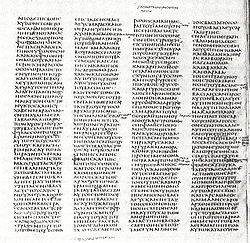Codex Sinaiticus
From CreationWiki, the encyclopedia of creation science
Jump to navigationJump to search
Codex Sinaiticus (קודקס סינאיטיקוס, Σιναϊτικός Κώδικας; Shelfmarks and references: London, Brit. Libr., Additional Manuscripts 43725; Gregory-Aland nº א [Aleph] or 01, [Soden δ 2]) is one of the four great uncial codices, an ancient, handwritten copy of the Greek Bible.[1] The manuscript was discovered by Constantin von Tischendorf in the monastery of St. Catherine at the foot of Mount Sinai. Date about 350 AD. and contains the entire New Testament and provides a reliable testimony of the autographs of the New Testament.[2]
References
- ↑ Metzger, Bruce; Bart D. Ehrman (2005). The Text of the New Testament: An Introduction to the Critical Editions and to the Theory and Practice of Modern Textual Criticism. New York – Oxford: Oxford University Press. p. 62. ISBN 978-0-19-516122-9.
- ↑ Comfort, Philip Wesley (1992). Comfort, Philip Wesley. ed. The Origin of the Bible. Wheaton, Illinois: Tyndale House Publishers. p. 180-181. ISBN 0-8423-4735-6.
